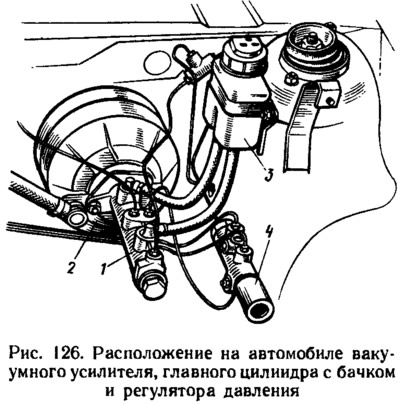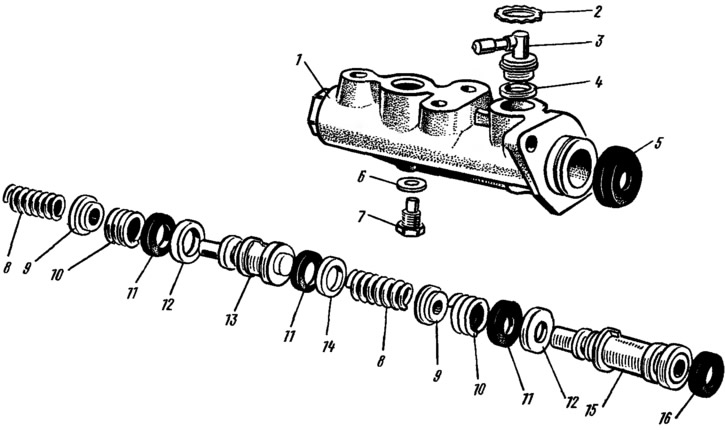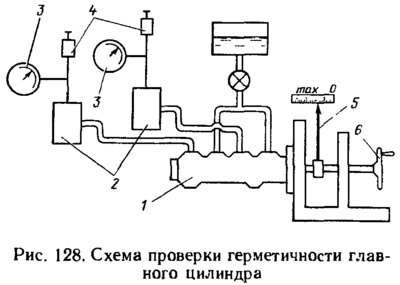Removal and installation
Disconnect hoses from master cylinder 1 (see fig. 126) and close the openings at the hoses and fittings of the master cylinder to prevent leakage of fluid and the ingress of dust, dirt and foreign matter into them.

Disconnect from the main cylinder the pipelines supplying fluid to the wheel cylinders of the front and rear brakes by unscrewing the nuts of their fastening.
Remove the cylinder by unscrewing the nuts securing it to the vacuum booster 2.
Installation of the master cylinder is carried out in the reverse order of removal. After installing the cylinder and pouring brake fluid into tank 3, the hydraulic drive system is pumped to remove air.
Disassembly and assembly
After unscrewing the locking screws 7 (pic. 127), sequentially take out all the details.

Pic. 127. Details of the main cylinder: 1 - cylinder body; 2 - lock washer; 3 - fitting; 4 - sealing ring; 5 - dust cap; 6 - sealing washer; 7 - piston lock screw; 8 - piston return spring; 9 - cup; 10 - clamping spring of the seal; 11 - high pressure sealing ring; 12 - spacer sleeve; 13 - floating piston; 14 - washer; 15 - pusher piston; 16 - low pressure sealing ring.
The assembly of the cylinder is carried out in the reverse order of disassembly. In this case, all parts are lubricated with brake fluid. Washers 6 under the locking screws are recommended to be replaced with new ones.
When assembling, use tool 67.7853.9543.
Checking parts before assembly
Before assembly, all parts are washed with hot water and detergents, dried with a jet of compressed air and wiped with a clean cloth, avoiding contact with mineral oils, kerosene or diesel fuel, which can damage the seals.
The cylinder mirror and the working surface of the pistons must be completely clean, free of rust, scratches and other defects. Each time the cylinder is disassembled, replace the O-rings with new ones, even if they appear to be in good condition.
The elasticity of the piston spring is checked, the length of which should be: 36 mm under a load of 35–42 N, 21 mm under a load of 63.5–73.5 N, 57.5 mm in a free state.
Master Cylinder Leak Test
The main cylinder 1 is installed on the stand BS-137.000 and connected to the elements of the stand, as shown in fig. 128.

Valves 4 are opened for laying the stand and, moving the pistons of the main cylinder several times to the full length of their stroke, the system is pumped. Then the valves 4 are closed. By rotating the flywheel 6, the pistons of the main cylinder are slowly advanced until the pressure controlled by the pressure gauges 3 reaches 12.5 MPa. In this position, fixed by pointer 5, the pusher of the master cylinder is blocked. The specified pressure must remain constant for at least 5 s. If fluid leaks or pressure changes within 5 seconds, replace the cylinder piston o-rings. To ensure the accuracy of pressure gauge readings 3, the stand is equipped with an absorbing cylinder 2.
